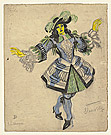Juan GRIS

José Victoriano Carmelo Carlos González Pérez (b Madrid, 23 March 1887 –d Boulogne-sur-Seine, France, 24 January 1927) studied at Madrid’s Escuela de Artes y Manufacturas but left to work under Spanish academic painter, José Moreno Carbonero. From 1905 he began to identify himself as a modernista or modern artist working in the international Art Nouveau style, and called himself Juan Gris.
In 1906 he left Spain permanently, moving to Paris where he associated with artists such as Pablo Picasso and Georges Braque. From 1912 he exhibited with the Salon des Indépendants and contributed to Cubist exhibitions, becoming a leading collagist, particularly with paper collage from 1913.
Through Picasso, Gris was introduced to Diaghilev and the Ballets Russes and watched the rehearsals of Parade. However, it was not until 1922 that he began to design for the company, with costumes and sets for Les Tentations de la bergère (1924). He also was commissioned by Diaghilev to design costumes and sets for the receptions and balls known as Fêtes Mervilleuses, held in the Hall of Mirrors at Versailles (1923). In 1924 he also provided designs for the comic opera La Colombe (The dove) and the one-act operetta Une Education manqué (An incomplete education). Both these productions were staged in Monte Carlo. In May 1924 Gris produced his final collaboration with Diaghilev, a Red Cross gala held at Les Grands Magasins du Printemps in Paris.
Man Ray
Juan Gris 1924 Man Ray Trust © Man Ray Trust/ADAGP. Licensed by Viscopy, 2010/Telimage, 2010





